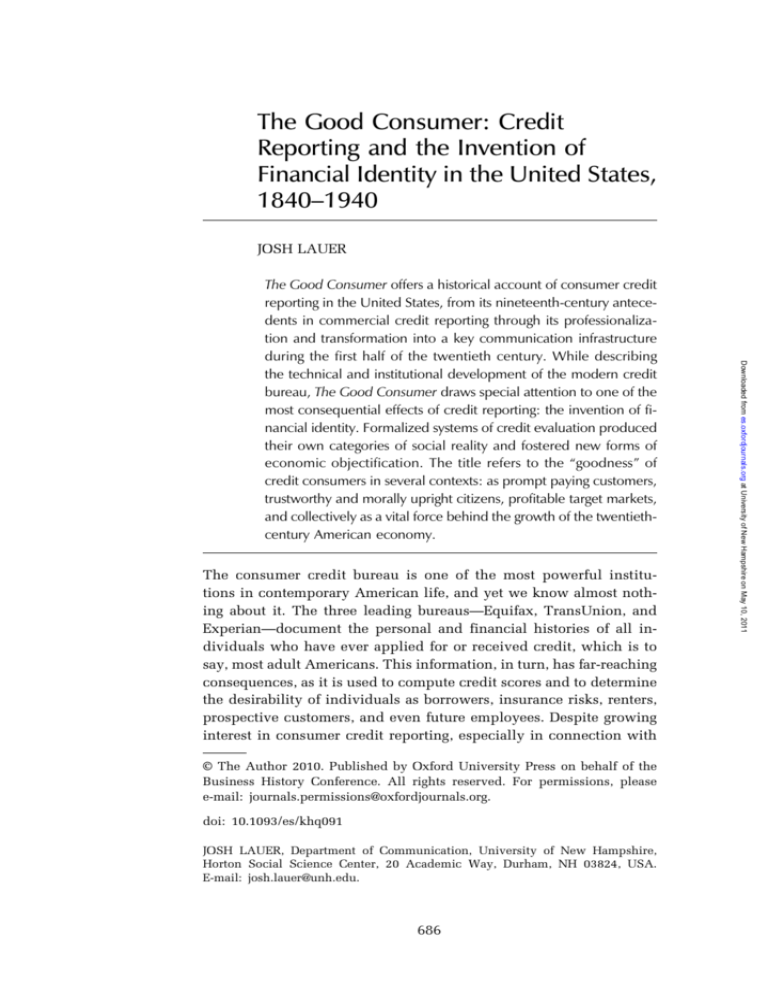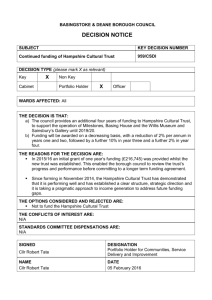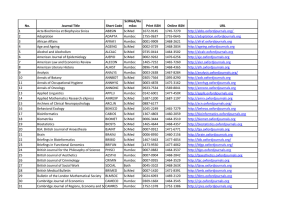
The Good Consumer: Credit
Reporting and the Invention of
Financial Identity in the United States,
1840–1940
JOSH LAUER
The consumer credit bureau is one of the most powerful institutions in contemporary American life, and yet we know almost nothing about it. The three leading bureaus—Equifax, TransUnion, and
Experian—document the personal and financial histories of all individuals who have ever applied for or received credit, which is to
say, most adult Americans. This information, in turn, has far-reaching
consequences, as it is used to compute credit scores and to determine
the desirability of individuals as borrowers, insurance risks, renters,
prospective customers, and even future employees. Despite growing
interest in consumer credit reporting, especially in connection with
© The Author 2010. Published by Oxford University Press on behalf of the
Business History Conference. All rights reserved. For permissions, please
e-mail: journals.permissions@oxfordjournals.org.
doi: 10.1093/es/khq091
JOSH LAUER, Department of Communication, University of New Hampshire,
Horton Social Science Center, 20 Academic Way, Durham, NH 03824, USA.
E-mail: josh.lauer@unh.edu.
686
Downloaded from es.oxfordjournals.org at University of New Hampshire on May 10, 2011
The Good Consumer offers a historical account of consumer credit
reporting in the United States, from its nineteenth-century antecedents in commercial credit reporting through its professionalization and transformation into a key communication infrastructure
during the first half of the twentieth century. While describing
the technical and institutional development of the modern credit
bureau, The Good Consumer draws special attention to one of the
most consequential effects of credit reporting: the invention of financial identity. Formalized systems of credit evaluation produced
their own categories of social reality and fostered new forms of
economic objectification. The title refers to the “goodness” of
credit consumers in several contexts: as prompt paying customers,
trustworthy and morally upright citizens, profitable target markets,
and collectively as a vital force behind the growth of the twentiethcentury American economy.
The Good Consumer
1. On the history of commercial credit reporting in the United States, see
Olegario, A Culture of Credit; Norris, R.G. Dun & Co., 1841–1900; Sandage, Born
Losers; Madison, “The Evolution of Commercial Credit Reporting Agencies in
Nineteenth-Century America”; Hidy, “Credit Rating before Dun and Bradstreet”;
and Atherton, “The Problem of Credit Rating in the Ante-Bellum South.”
Downloaded from es.oxfordjournals.org at University of New Hampshire on May 10, 2011
the rise of database surveillance and the scourge of so-called identity
theft, no comprehensive analysis of this institution exists. Even more,
as the recent subprime mortgage debacle and cascading financial crisis have illustrated, the management of credit risk is at the very foundation of our economy.
Though imagined as a recent technological development, a product
of database computing since the 1960s, the history of consumer credit
reporting is much longer and its significance more profound. The
Good Consumer offers a historical account of consumer credit reporting in the United States, from its nineteenth-century antecedents in
commercial credit reporting through its professionalization and transformation into a key information infrastructure in the twentieth century. The title refers to the “goodness” of credit consumers in several
contexts: as prompt paying customers, as trustworthy and morally upright citizens, as profitable target markets, and collectively as a vital
force behind the growth of the twentieth-century American economy.
The Good Consumer is guided by three basic questions. The first is
historical: How did consumer credit reporting come into existence—
what economic, social, and professional forces surrounded its early
development and consolidation before 1940? The second is technical:
How were informal, face-to-face credit relationships converted into
bureaucratic systems of information exchange—what recordkeeping
practices, communication technologies, and administrative procedures were adopted to systematize credit reporting? The third is cultural: What are the social implications of this new system of mass
surveillance—how did the rationalization of impersonal credit relationships work to objectify individuals, classify and track American
citizens, and produce the modern concept of financial identity?
The periodization of The Good Consumer, beginning in 1840, may
seem odd given that the first organizations devoted to consumer credit
reporting did not exist until the 1870s. However, the development of
consumer credit reporting cannot be understood without examining
the institution that informed it: the commercial credit reporting agency. During the 1840s, pioneering commercial credit reporting firms
such as Lewis Tappan’s Mercantile Agency and John Bradstreet’s
Commercial Agency—together, the future Dun & Bradstreet—established far-flung surveillance networks to identify, monitor, and evaluate the credit standing of American business owners throughout the
nation.1 Importantly, these first credit agencies were relegated to the
687
688
LAUER
2. On the history of consumer credit before 1940, see Calder, Financing the
American Dream; Horowitz, The Morality of Spending; Olney, Buy Now, Pay
Later; and Leach, Land of Desire.
Downloaded from es.oxfordjournals.org at University of New Hampshire on May 10, 2011
world of commercial credit—that is, “productive” rather than “consumptive” credit. Though historians of commercial credit reporting
have tended to ignore the development of consumer reporting, perhaps reflecting a conventional philosophical division between the
two forms of credit, The Good Consumer draws attention to their interconnection.2 Consumer creditors—especially grocers, butchers, installment dealers, and department stores—not only looked to
commercial credit reporting for inspiration but also joined the same
business associations as commercial creditors and read the same instructional texts and trade publications as they professionalized during the 1890s. More importantly, the concept of financial identity,
implicit in the disciplinary surveillance of credit reporting, would assume special significance as an emergent category of social reality
that fostered new forms of economic objectification.
The first consumer credit reporting organizations appeared in New
York during the 1870s, and by the 1890s scores of others could be
found in American cities from coast to coast. Unlike the history of
commercial credit reporting, which is well preserved in the R.G.
Dun archive at Harvard’s Baker Business Library, the early development of its consumer counterpart is far more difficult to reconstruct
with precision. The first consumer credit reporting operations were
either too short-lived or insignificant to produce institutional archives, making the order and pattern of their diffusion difficult to
track. These nascent information-sharing organizations sprang up
throughout the United States in a striking variety of forms. Some were
private agencies modeled directly on commercial credit reporting
agencies, some were non-profit associations organized along trade
lines, and still others were dubious offshoots of collection and detective agencies. All of these varied considerably in their methods of reporting as well, from the compilation of simple black lists to the
publication of comprehensive reference books based upon the affirmative–negative system. Since there was little or no coordination
among retailers in different cities, each new organization was a veritable island unto itself, seemingly oblivious to the success or failure of
others.
Disorganized and fragile, these early organizations struggled to
provide affordable service and to maintain the participation of suspicious merchants, whose confidential ledgers they depended on for
credit information. During the 1910s, newly professionalized credit
managers, most of who came from department stores and installment
The Good Consumer
3. Wilson, “A Declaration of Independence and a New Freedom,” SM6.
Downloaded from es.oxfordjournals.org at University of New Hampshire on May 10, 2011
houses, worked together to develop cooperative credit reporting organizations in their communities and to codify protocols of information gathering. In 1912 the Retail Credit Men’s National Association
(renamed the National Retail Credit Association in 1927) was formed
to represent their professional interests, and their membership
quickly grew. Between the First and Second World Wars the national association devoted itself to public relations campaigns that emphasized the moral foundation of credit and the dire implications of
poor credit ratings. These campaigns, some of which were lavish
multi-media blitzes, urged American citizens to “Treat their credit
as a sacred trust.” By 1940 the association succeeded in establishing
an ambitious national reporting network that operated with remarkable efficiency. It was comprised of more than one thousand four
hundred credit bureaus, which together maintained records for more
than sixty million Americans.
Between 1840 and 1940 the American “credit system” evolved into a full-fledged national credit economy, one that spanned a continent and involved new systems of finance, manufacture,
distribution, and retailing through which millions of strangers transacted with one another. The growing impersonality of economic life
was underscored by President Woodrow Wilson in one of his “plain
talks” to the American people in 1913. Railing against the tyranny of
big corporations and monopolistic trusts, he pointed to a fundamental shift in the everyday experience of twentieth-century Americans.
“We have changed our economic conditions absolutely, from top to
bottom; and, with our economic society, the organization of our
life,” he declared. “Today, the everyday relationships of men are
largely with great impersonal concerns, with organizations, not with
other individual men. Now this is nothing short of a new social age,
a new era of human relationships, a new stage setting for the drama
of life.”3 Wilson, to be sure, did not have credit reporting in mind.
Yet the estrangement of employers and laborers that he condemned
ran parallel to that of creditors and borrowers. The rise of the consumer credit bureau and in-store credit departments reflected the
growing impersonality of economic relationships, a process that
was already underway when the first mercantile agencies were
formed after the Panic of 1837.
In 1913, the same year as Wilson’s talk, such impersonality was
dramatized in a Cleveland department store when a conscientious
young sales clerk phoned the credit department to verify the account status of a man she did not recognize. The customer, John
D. Rockefeller, was in fact the richest man in the United States. Tak-
689
690
LAUER
4. “No Rockefeller Credit,” 1.
5. “The Praise of Debt,” 338.
6. Goddard, Giving and Getting Credit, 30–31.
Downloaded from es.oxfordjournals.org at University of New Hampshire on May 10, 2011
ing it in stride, Rockefeller excused the clerk with a smile and noted
that “her caution deserved approval by her employers.”4 But while
the absurdity of the incident was comic fodder for newspapers
throughout the country, Rockefeller’s interrogation revealed something else: systematic credit investigation had become entirely commonplace. Even Rockefeller, a man who in earlier times would have
been trusted simply on the strength of his name, was subjected to
this new credit reporting regime.
Paradoxically, the foundation of credit—whether granted for commercial investment or personal consumption—had not changed at all.
Credit depends upon the faith one party has in the good intentions
and reliability of another; it is thus intensely personal. In 1833 one
writer noted with sarcasm that “A debtor is a man of mark. Many eyes
are fixed upon him; many have interest in his well being; his movements are of concern; he cannot disappear unheeded; his name is in
many mouths; his name is upon many books; he is a man of note—of
promissory note; he fills the speculation of many minds; men conjecture about him, wonder and conjecture whether he will pay.”5 During
the early nineteenth century, the information upon which individuals
made such calculated leaps of faith—personal acquaintance and community opinion—the underpinnings of credit itself, began to come undone. Amid the tumult of the market revolution, the mercantile
agency system introduced a technical solution to the problem of credit
evaluation. Where informal, embodied ways of knowing were no longer feasible or considered reliable, a national apparatus of remote surveillance was developed to communicate detailed information about
the character and finances of individuals for the consideration of distant creditors. With its quasi-empirical ratings and aspirations to scientific precision, credit bureaus provided solace and a measure of
confidence for creditors who no longer knew their customers.
At the same time, the complexity of the national credit economy
and its increasing mediation by institutions such as credit bureaus obscured as much as it revealed. As the author of an 1895 credit textbook
remarked, “In the complex march of modern affairs, business has become more mechanical. We have lost the personal equation of our customers, or get it only at second-hand. The name of the debtor or
creditor on our books is only a symbol which might as well be represented by a number.”6 In less than a century the great chain of credit
and its deeply personal relationships had become unfamiliar to many
Americans. The nineteenth-century interdependencies of the farmer,
The Good Consumer
7. “Credit Men,” 66.
Downloaded from es.oxfordjournals.org at University of New Hampshire on May 10, 2011
the butcher, and the shoemaker had lost their valence in a twentiethcentury world of strangers. By the end of the nineteenth century, retailers, like commercial creditors before them, found it difficult to evaluate the creditworthiness of their more numerous and mobile
customers. Moreover, the threat of social sanction that compelled
many individuals to honor their debts in small communities exerted
little force in cities and towns where they were often anonymous and
transient. The problem of collecting debts was not new to late
nineteenth-century retailers; grocers, tailors, physicians, and publishers had long complained of their victimization by negligent clients.
But under new pressures to compete, small storekeepers as well as
mass retailers—especially department stores—felt forced against their
better judgment to provide credit accommodations.
Early retail credit managers were eager to embrace new methods
for gathering, transcribing, and processing information about their
credit customers. Their professionalization embodied the progressive
ideals of scientific management at the turn of the century. The movement toward systematic credit management, like the development of
commercial credit reporting a half century earlier, sought to convert
informal and embodied knowledge into easily learned and transferable textual protocols. The adoption of standardized forms, filing systems, and cooperative networks of information exchange all worked
toward this end while adding a patina of formal expertise and legitimacy to the new profession. However, where commercial creditors
worked to impose a new spirit of transparency through the use of
signed financial statements, retail creditors sought to lay bare the
character—the moral disposition and behavior—of consumers in personal interviews and in the analysis of ledger experience that revealed
patterns of responsibility or neglect (or more often a confounding mix
of both). In 1936 a Time magazine story suggested that it was futile to
hide one’s private life or past mistakes; they would be quickly uncovered by the credit bureau. Investigating a Chicago woman who had
relocated to Los Angeles, for example, the bureau “might learn that
she was a widow of 40 with no children, enjoyed no visible means
of support, lived in swank apartments, entertained unsavory characters, was late with her rent, lived in Chicago for only two years and
left with $500 of unpaid bills.”7
Interestingly, as intellectuals struggled to come to terms with mass
society during the 1920s and 1930s, retail credit managers were already working to deconstruct the mass—to isolate the individual
and his or her personal characteristics and buying behavior. The development of consumer credit reporting was characterized, above all,
691
692
LAUER
8. Green, “They Get All the Credit,” 68.
Downloaded from es.oxfordjournals.org at University of New Hampshire on May 10, 2011
by fundamental tensions between vying forms of knowledge: embodied versus textual, intuition versus science, singularity versus standardization, and subjectivity versus system. These tensions were
largely resolved, in principle if not in practice, during the 1970s
and 1980s when consumer credit reporting was computerized and
consolidated in the hands of several national corporations.
Though consumer credit reporting originated among retailers, it
soon became a valued resource in other domains. During the 1920s
public utilities turned to credit bureaus for information, as did personal finance companies, the Federal Housing Administration, and
law enforcement agencies. Real estate companies and landlords also
employed the services of the credit bureau. The information in their
voluminous files, a business magazine reported, was used to investigate the “playing habits” rather than the “paying habits” of tenants.
“Credit bureau files have turned up such fascinating characters as
the man who kept a live alligator in his bath tub, another who decorated apartment walls with risqué murals,” as well as noisy musicians, “chronic jitter-bugs” who caused chaos with their late-night
“rug-cutting,” and “fire-bugs.”8
Early credit professionals were earnest in their desire to collect and
compile only “facts” about individual consumers. Though categories
of analysis such as occupation, gender, race, and residence were used
to infer degrees of individual moral hazard that have since been outlawed, these categories and their discriminatory application were a
reflection of cultural values implicit in white, middle class, maledominated American society during the first half of the twentieth century. This is to say, early credit professionals were not wholly responsible for the discriminatory practices they codified, though they did
much to institutionalize them in their credit reporting protocols.
Their commitment to cooperation and progressive business practices
was certainly self-serving, but it also contributed toward a more equitable expansion of personal credit. Those of modest means—wage
workers and laborers, both male and female—might be able to purchase goods formerly out of reach. Still, credit privileges came with
strings attached. To participate, one entered into a system of surveillance that was disciplinary by design; its implicit function was to regulate individual behavior. In 1929 sociologists Robert and Helen Lynd
noted the peculiar disciplinary effects of credit relationships in smalltown America. The “sensitive institution of credit,” they observed,
“serve[d] as a repressive agent tending to standardize widening sectors of the habits of the business class—to vote the Republican ticket,
to adopt golf as their recreation, and to refrain from ‘queer,’ i.e., atyp-
The Good Consumer
9. Lynd and Lynd, Middletown, 47. Though commenting specifically about
commercial rather than consumer credit, their observations are relevant to both.
10. U.S. House, Report of the Committee Appointed Pursuant to House
Resolutions 429 and 504 to Investigate the Concentration of Control of Money
and Credit, 136.
11. Fair Credit Reporting Act.
Downloaded from es.oxfordjournals.org at University of New Hampshire on May 10, 2011
ical behavior—will be noted.”9 Credit relationships, they realized, imposed normative standards that regulated the conduct of individuals,
even in seemingly non-economic aspects of life such as politics and
sports.
What is most striking about the history of American credit
reporting—and consumer credit reporting in particular—is that it reveals the irreducibly social nature of all credit relationships, past and
present. The computerization of credit assessment, particularly the
use of sophisticated credit scoring programs such as Fair Isaac’s FICO
algorithm, has done much to depersonalize credit evaluation in recent
decades, to the extent that credit risk is often perceived as a valuefree technological problem. Instead of laying bare our personal and
financial situation before a skeptical credit manager, credit applications are now processed by remote, faceless institutions: numbers
in, numbers out. However, The Good Consumer seeks to remind us
that creditworthiness is not simply a reflection of one’s ability to
pay—one’s capital and earning power—but one’s willingness to pay.
For this reason, character—one’s reputation for honesty, integrity,
and moral respectability—was held to be the most reliable measure
of creditworthiness well into the twentieth century. When financier
J.P. Morgan was asked during a 1912 congressional inquiry if credit
was “based primarily upon money or property,” he famously corrected,
“No, sir; the first thing is character.”10 Character, however, is no quaint
relic of a bygone era; indeed, it is very much alive. Consumer credit reports, according to the Fair Credit Reporting Act’s current definition,
consist of information regarding an individual’s “character, general
reputation, personal characteristics, or mode of living” in addition to
one’s financial means and past payment history.11 Financial identity,
as I argue in The Good Consumer, is a form of moral identity.
But while pointing to the conflation of the economic and the moral,
it would be disingenuous to suggest that they should be held separate.
The problem of credit reporting and financial identity is not that they
should be more objective or technologically sophisticated but that the
economic is always embedded in the social and thus cannot help but
reflect certain moral assumptions. In the end, all systems of credit
reporting, including those used to identify, track, and predict the behavior of consumers, are also systems of moral communication. As a
693
694
LAUER
mechanism of social control, financial surveillance works, if it works
at all, because it is also a form of moral accounting.
Bibliography of Works Cited
Downloaded from es.oxfordjournals.org at University of New Hampshire on May 10, 2011
Atherton, Lewis E. “The Problem of Credit Rating in the Ante-Bellum South.”
Journal of Southern History 12 (1946): 534–56.
Calder, Lendol. Financing the American Dream: A Cultural History of Consumer Credit. Princeton, NJ: Princeton University Press, 1999.
“Credit Men,” Time, 22 June 1936, 66.
Fair Credit Reporting Act, 15 U.S. Code, 1681a, sec. 603.
Goddard, Frederick. Giving and Getting Credit: A Book for Business Men. New
York, NY: Baker & Taylor, 1895.
Green, Paul D. “They Get All the Credit.” Nation’s Business 33 (1945): 68.
Hidy, R.W. “Credit Rating before Dun and Bradstreet.” Bulletin of the Business
Historical Society. 13 (1939): 81–8.
Horowitz, Daniel. The Morality of Spending: Attitudes toward the Consumer
in Society, 1875–1940. Baltimore, MD: Johns Hopkins University Press,
1985.
Leach, William. Land of Desire: Merchants, Power, and the Rise of a New
American Culture. New York, NY: Vintage, 1993.
Lynd, Robert S, and Helen Merrell Lynd. Middletown: A Study in American
Culture. New York, NY: Harcourt, Brace, 1929.
Madison, James H. “The Evolution of Commercial Credit Reporting Agencies in
Nineteenth-Century America.” Business History Review. 48 (1974): 164–86.
“No Rockefeller Credit.” New York Times, 22 November 1913, 1.
Norris, James D. R.G. Dun and Co., 1841–1900: The Development of CreditReporting in the Nineteenth Century. Westport, CT: Greenwood Press,
1978.
Olegario, Rowena. A Culture of Credit: Embedding Trust and Transparency in
American Business. Cambridge, MA: Harvard University Press, 2006.
Olney, Martha L. Buy Now, Pay Later: Advertising, Credit, and Consumer Durables in the 1920s. Chapel Hill, University of North Carolina Press, 1991.
“The Praise of Debt.” Philadelphia Album and Ladies Literary Portfolio, 7
December 1833, 338.
Sandage, Scott A. Born Losers: A History of Failure in America. Cambridge,
MA: Harvard University Press, 2005.
U.S. House. Report of the Committee Appointed Pursuant to House Resolutions 429 and 504 to Investigate the Concentration of Control of Money
and Credit, 62nd Cong., 3rd sess., 1913.
Wilson, Woodrow. “A Declaration of Independence and a New Freedom.”
Boston Globe, 1 June 1913, SM6.





